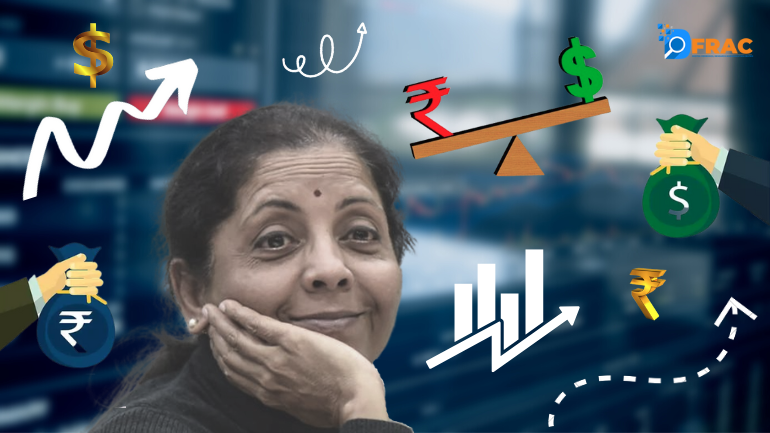Even though India remains an aberration among the world’s major economies in staving off inflation and currency depreciation, Finance Minister Nirmala Sitharaman became the butt of jokes recently while drawing criticism for her remarks on the strengthening of the US dollar against other currencies.
“The rupee is not slipping but the dollar is getting stronger,” said Nirmala Sitharaman.
While speaking to reporters after attending the annual meetings of the International Monetary Fund (IMF) and the World Bank, Sitharaman said the fundamentals of the Indian economy were strong and inflation was low as compared to other parts of the world.
Responding to a question on a weak rupee, she said, “First of all I would see it as a depreciation in the rupee, I would see it as a strengthening of the dollar, a continuing strengthening of the dollar.”
All other currencies across the world are performing against a strong dollar, she added.
“And I’m not talking about technical things, but it’s a matter of fact that the Indian rupee is probably going above this dollar rate, the exchange rate is in favor of the dollar strengthening and I think the Indian rupee has performed significantly better than many other emerging market currencies,” she said.
Skeptics and Modi government critics mocked the finance minister for her fast-paced monetary policy take on India in the wake of unprecedented inflation and accompanying volatility amid the Russia-Ukraine crisis. But an analysis of the data available to support Sitharaman’s claim shows that the finance minister was actually spot on in her argument.
The story behind drastic growth of US Dollar
Firstly, there are many factors affecting the value of a currency. One of them is the interest rates that the Reserve Bank manages to control the circulation of money in the economy. The US Fed has raised rates five times this year, most recently by three-quarters of a percentage point in September in its bid to fight inflation. The US is facing unprecedented inflation in decades, a V-shaped recovery after the coronavirus pandemic brought the country to a standstill. The unemployment rate in the US is at a record low, which has contributed to the skyrocketing inflation. These developments prompted the US Fed to continuously raise interest rates, which are nothing more than an attempt to limit the amount of money available in the market. By raising interest rates, the Fed aims to take money out of the economy and put it in a state of deflation to cope with rising prices.
However, this is just one aspect of the interest rate. Higher interest rates also provide investors with better returns in US markets than elsewhere, which is one reason why foreign investors pull money invested in various markets around the world and park it in the US market. This, in turn, increases the demand for the US currency, the USD, which increases the value of the dollar in the international market.
In addition, the dominance of the USD in international finance and trade, particularly in energy trading, also has a domino effect in strengthening the US currency. The US dollar rules the world economy as compared to other currencies including the Indian dollar, Chinese yuan, Russian ruble, etc. The dollar’s dominance over economies also contributes to the strengthening of the US currency amid inflation and global volatility.
To deal with a US Fed rate hike that strengthens the dollar, which in turn gives much power to world trade, countries take appropriate action to control domestic inflation and price hikes, usually involving the respective countries’ reserves. It involves raising interest rates for banks. This is the reason why the Reserve Bank of India has increased interest rates in the last few months. But the measure involves a spillover effect of sorts as it reduces demand not only for domestic production but also for imports, failing to take into account what could inadvertently induce a sharp global recession.
Countries around the world have to navigate the chain of containing inflation, but not so much that is driving them into recession. Other factors have also contributed to the strengthening of the US dollar, but they are beyond the scope of this article. So when Nirmala Sitharaman said that it is not the Indian rupee that is slipping but the US dollar getting stronger, she accurately explained the riddle facing the Indian economy. Add the ongoing war between Russia and Ukraine to the mix, and the complications get even more complicated. The US Dollar hasn’t had much impact on Russian currency as the latter is not trading enough with the world.
Indian Rupee stronger in comparison to other major currencies
Stating that the US dollar has strengthened, Nirmal Sitharaman also said that India has outperformed some of the world’s major economies. So, how the rupee has performed against some of the top currencies of the world
How INR coping up with USD
Since the start of the Russo-Ukraine War on February 24, 2022, which acted as an impetus for the global financial crisis, especially, consumer food inflation which has reached record levels, given that both Russia and Ukraine are one of the top exporters of wheat, and with many African and Latin American countries highly dependent on Moscow and Kyiv for their grain requirements, the Indian rupee has depreciated against its US counterpart. From Rs 74.64 equivalent to 1 USD on February 24, it has come down to Rs 82.54 on October 22, which is close to a 9 percent fall in its value.
However, the Indian rupee has outperformed many other major economies and has managed to limit its slide against the all-powerful dollar, due to interventions by the Reserve Bank of India.
USD hammers Euro
Before the start of the war, 1 USD amounted to 0.89 EUR, but today, i.e. on October 22, 2022, 1 USD is equal to 1.03 EUR, which is a staggering 17 percent depreciation in its value over the course of about 8 months.
GBP hit hard by USD
Similar is the case with the pound sterling, which has registered a fall of 18 percent against the US dollar. On 24 February, one dollar was equal to 0.75 GBP. However, its value fell to 0.89 on October 22, 2022.
The battle between USD vs Chinese Yuan
Similarly, the Chinese yuan has also suffered significantly in the 8 months since the war broke out and amid periodic rate hikes by the US Fed. One US dollar is currently equal to 7.2 Chinese Yuan while it was 6.33 Chinese Yuan before the war started in February 2022.
Taken together, the Indian rupee has been one of the choices of currencies to push back against an ominously rising US dollar months after a devastating bout of the coronavirus outbreak that cratered economies and brought more countries to a standstill. While the Indian rupee has depreciated 9 percent in the past 8 months, most other major currencies have declined in double digits, establishing India’s impressive handling of the economy, which has also earned them praise from IMF officials, who recently appreciated the Government of India for efficient management of multiple crises in an uncertain global environment.
While each country has a unique set of challenges and shares different geographic and geological features, strengths, and weaknesses, the fact that the Indian rupee has outperformed most of the world’s major currencies reflects the survival skills of the Indian economy in a volatile economic world. The once-in-a-lifetime crisis, especially in the wake of a global pandemic that has wreaked havoc and bled economies across the globe, underscores the resolve to build a strong and resilient India that remains as untouched by global shocks as possible.





